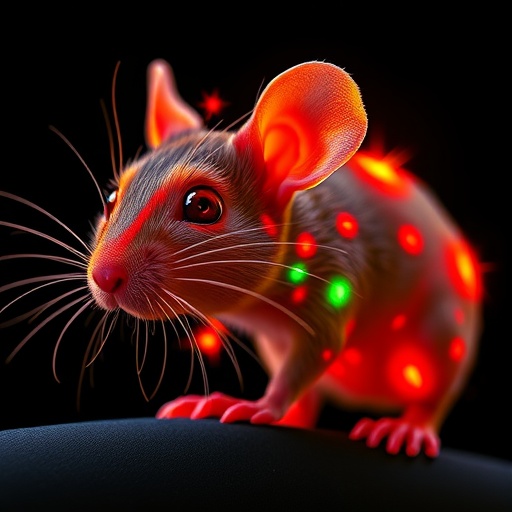The intricate relationship between genetics and neurological disorders has been a focal point of contemporary neuroscientific research. Highlighting this critical area, a groundbreaking study published in Cell Death Discovery introduces a novel knock-in mouse model designed to probe the pathophysiology of GABRG2-related epileptic encephalopathy. This genetic disorder, linked to debilitating epilepsy forms and cognitive deficits, has long puzzled researchers due to its complex molecular underpinnings. By faithfully recapitulating the human condition in an animal model, this research offers unprecedented insight into the spontaneous seizure patterns and associated cognitive impairments, opening new doors for therapeutic interventions.
Epileptic encephalopathies represent a group of severe brain disorders characterized by early-onset, refractory seizures and a substantial impact on cognitive development. Among the numerous molecular players involved, mutations in GABRG2—encoding the gamma-2 subunit of the GABA_A receptor—have emerged as pivotal contributors. GABA_A receptors mediate inhibitory neurotransmission in the central nervous system, thus maintaining the crucial excitatory-inhibitory balance. Dysfunctional inhibitory signaling due to GABRG2 mutations disrupts this balance, precipitating hyperexcitability and epileptogenesis.
The new mouse model described by Shen et al. incorporates a precise knock-in of a mutant GABRG2 gene variant, mirroring pathogenic human mutations. This approach enables an accurate simulation of the disease phenotype in vivo, addressing limitations of previous models which either lacked specificity or failed to exhibit spontaneous seizures. Mice carrying this mutation demonstrate spontaneous generalized seizures that resemble clinical presentations in affected patients, providing a robust platform for experimental manipulation and longitudinal studies.
Importantly, the study reveals that these genetically modified mice also exhibit significant cognitive impairments, paralleling the intellectual disabilities seen in human epileptic encephalopathy sufferers. Behavioral assays uncover deficits in learning and memory, supporting the hypothesis that GABRG2 mutations compromise not only seizure thresholds but also neural circuits governing cognition. This dual phenotype underscores the receptor’s broader role in neurodevelopment and synaptic integration beyond seizure predisposition.
Electrophysiological analyses within this model have further elucidated the disrupted inhibitory synaptic transmission attributable to GABRG2 mutations. Patch-clamp recordings from cortical neurons reveal diminished GABAergic currents, indicating a direct functional consequence of the altered gamma-2 subunit. These findings validate the hypothesis that loss of inhibitory tone leads to enhanced neuronal excitability, triggering seizures and subsequent network instability that impairs cognitive processing.
At the molecular level, the knock-in mutation appears to affect receptor assembly, trafficking, and surface expression, contributing to its functional deficits. Immunohistochemical imaging within the cerebral cortex indicates a marked reduction of functional GABA_A receptors at synaptic sites. This receptor hypofunctionality elucidates the mechanistic link between genetic mutation and clinical manifestation, emphasizing receptor biology as a targetable axis for future drug development.
The translational impact of this model is profound. By faithfully replicating the spontaneous seizure phenotype seen in human epilepsy, it sets the stage for preclinical testing of novel pharmacotherapies aimed at restoring GABAergic signaling. Moreover, it provides an invaluable tool to dissect the temporal progression of encephalopathy, discerning early pathogenetic events and windows for intervention before irreversible cognitive decline sets in.
Shen and colleagues’ work also brings renewed attention to the heterogeneity of epileptic encephalopathies, stressing the necessity for precision medicine approaches. Different mutations in GABRG2 may induce variable phenotypes, and this model facilitates comparative studies of mutant alleles under controlled genetic backgrounds. Such nuanced insights may inform patient stratification and personalized therapeutic regimens in the clinic.
In addition to its utility in epilepsy research, the novel knock-in mouse offers broader implications for neurodevelopmental disorder studies. Given the central role of GABAergic inhibition in sculpting neural circuits, disruptions as modeled here could illuminate pathways relevant to autism spectrum disorders, intellectual disabilities, and other cognitive conditions frequently comorbid with epilepsy.
Nevertheless, challenges remain in fully capturing the complexity of human pathological states in animal models. Although the knock-in approach refines genetic accuracy, interspecies differences in brain architecture and lifespan limit direct extrapolation. Ongoing refinement of behavioral paradigms and incorporation of advanced neuroimaging techniques will enhance model fidelity and facilitate deeper mechanistic understanding.
Furthermore, this study highlights the intricate interplay between genetics, neural excitability, and cognition, underscoring the brain’s vulnerability to molecular disturbances during critical developmental windows. Intervening at points where receptor dysfunction initiates epileptogenesis could radically alter disease trajectories, preventing not only seizures but also the associated cognitive morbidities.
The development of this GABRG2-specific knock-in mouse is thus a landmark achievement, merging genetic precision with phenotypic relevance. As epilepsy research advances toward targeted gene therapies, such models will be indispensable in validating efficacy and safety before clinical translation. They represent the frontline in a era where mechanistic depth meets translational promise.
In conclusion, the innovative mouse model designed by Shen et al. marks a significant step forward in decoding the enigmatic mechanisms of GABRG2-related epileptic encephalopathy. By unveiling not only seizure phenotypes but also cognitive dysfunction, it accentuates the multifaceted impact of genetic mutations on brain function. This work propels the field toward targeted therapeutics that could ultimately relieve millions affected by refractory epilepsies and associated cognitive impairments worldwide.
As research continues to unravel the complexities of inhibitory neurotransmission and epilepsy, tools such as this knock-in model will remain central to discovery efforts. They provide a powerful means to simulate human disease in the laboratory and to dissect the cascade of molecular events culminating in clinical sequelae. The future holds promise that such insights will translate into better lives for patients and their families coping with these devastating neurological disorders.
Subject of Research: GABRG2-Related Epileptic Encephalopathy and associated spontaneous seizures and cognitive impairment in a knock-in mouse model
Article Title: A knock-in mouse model for GABRG2-related epileptic encephalopathy displays spontaneous generalized seizures and cognitive impairment
Article References:
Shen, D., Wan, J., Zhang, X. et al. A knock-in mouse model for GABRG2-related epileptic encephalopathy displays spontaneous generalized seizures and cognitive impairment. Cell Death Discov. 11, 443 (2025). https://doi.org/10.1038/s41420-025-02759-4
Image Credits: AI Generated
DOI: https://doi.org/10.1038/s41420-025-02759-4
Tags: animal models in neurosciencecognitive deficits in epilepsyepileptic encephalopathy studiesexcitatory-inhibitory balance in the brainGABA_A receptor mutationsGABRG2 epilepsy researchgenetic disorders and seizuresknock-in mouse modelneurotransmission and epilepsypathophysiology of seizuresspontaneous seizure patternstherapeutic interventions for epilepsy





